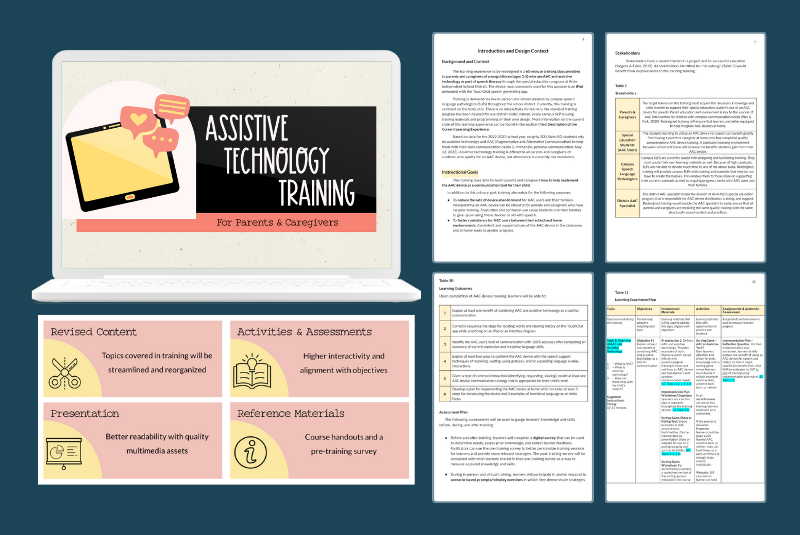A comprehensive plan for restructuring and repackaging an existing training course on supporting students who use assistive technology.
Authoring Tool: Microsoft Word, Google Slides, Canva
Overview: In April 2023, I participated in an online training session for my son’s assistive technology device, provided as part of his speech therapy services through our local school district. After a few conversations with his campus speech language pathologist, I learned that this training was required for parents and caregivers, but no standardized version had ever been made. Each campus had a different course and the task of creating these had been given to speech therapists who had no real experience designing training. I offered to create a plan for redesigning the course because I saw it as a good opportunity to combine my classwork with something of service to the local school district. It was also a chance to try out being a freelance instructional designer. I was able to network with specialists and SLPs and also learn more about how best to help my son with his assistive technology.
Purpose: This design case proposes a plan for redesigning a training course for parents and caregivers with children receiving speech therapy services. This course is offered through my local school district. Students who qualify are able to receive assistive technology in the form of an iPad with a generative speech app which helps them communicate. Parents and caregivers learn how to use the device as well as how to best support their student so that they’re successful with assistive technology. The design case document is a comprehensive outline of my plan for restructuring and repackaging this course, including learning outcomes, activities, assessments, and suggested supplemental materials.
Process: As the first step towards redesigning this course, I conducted a needs analysis of the organization, learners, and existing training. This involved interviews with the speech therapist at my son’s elementary school, the AAC specialist for the district, and a small focus group of parents/caregivers who had already participated in training. Part of my needs analysis involved reviewing existing materials for the course.
I compiled the analysis and used it to create a pitch deck for my proposed redesign. Based on feedback from stakeholders, subject matter experts, and peers from my degree program, I began planning the redesigned learning experience. My plan involved a new and more interactive presentation for facilitators to use, which would be standardized for all AAC training within the district, and supplementary learning materials such as a course workbook and job aids. These suggestions were made with the district’s budgetary constraints in mind. All materials for the course would be designed for use with the Google apps suite, which is already in use at every campus. As much as possible, existing resources would be repurposed and incorporated into the new version of the course.
Campus speech therapists are the facilitators for this training. Their workload and shortage of time were elements that were very much at the heart of many design decisions. So that campus SLPs would be able to continue running sessions online for those who could not attend in person, the course is designed to be adaptable to both delivery methods. There are few assessments requiring SLPs to sit down and grade; quizzes are self-checking and peer-to-peer review is built into the course to ease facilitator burden.
Lastly, to avoid overwhelming parents and caregivers new to assistive technology, the course is structured to be beginner-friendly. Concepts are scaffolded from foundational to more advanced. A new policy of checking in with parents post-training at least once per quarter was pitched to stakeholders and approved. This ensures that learners are not feeling abandoned once training is completed. It also results in greater success for the district’s students who are AAC users, as they are able to receive better support at home.
VIEW THE DESIGN CASE (PDF)
Related Resources: Course Redesign Pitch Deck

